It is that glorious time of the year again—the days are longer and temperatures are warming, prompting many of us to dust off our side-by-sides and ATVs.
When preparing for your motorized backcountry adventures, it is important to have a few key items along for the ride to save yourself from headache and frustration should you become stranded. For some adventures, you’ll pack lighter than for others, so here is a list of suggestions to help you prepare your own essentials kit for emergencies in the backcountry.
Tool kit basics
It’s important to have a few tools with you as you head out into the backcountry. Mechanical breakdowns can happen, but with a few handy tools you may be able to repair the machine and salvage the rest of your day. Here are some suggestions:
- Vice grips
- Crescent wrench
- Multi tool
- Allen and hex key set
- Tape, including electrical tape and duct tape
- Zip ties, tie-down straps and bungee cords
- Hose clamps
- Small socket set
- Multi-bit screwdriver
- Extra spark plugs and drive belt
When changing a belt on the fly, some machines can be less user-friendly than others. Familiarize yourself with all that is needed to change your machine’s belt, and be sure to pack the appropriate tools needed.
Space-saving tip: A great tip from Kootenay Speed Shop mechanic Daniel Thompson is to take a crescent wrench and wrap it in wire and tape to keep everything organized and to save space.
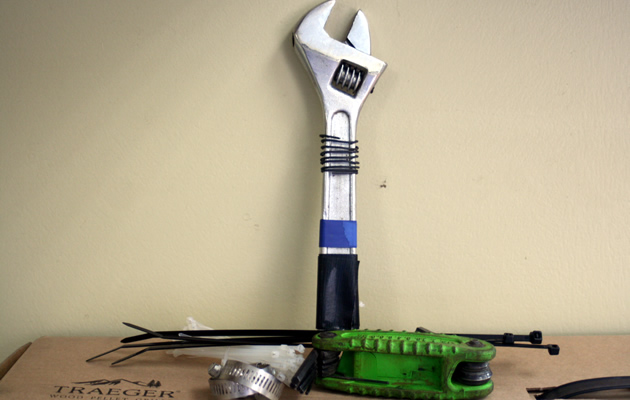
Space saving tip: Wrap a crescent wrench with tape and wire to keep it organized and compact. — Trish Drinkle photo
Tire repair
When it comes to tire repair on the fly, there are a few options to choose from:
- Tire repair kit or tire plugs
- Tire sealant spray
- Spare tire
Based on an online survey that was delivered to social media followers, tire plugs as opposed to tire sealant spray seemed to be the overwhelming favourite. Tire sealant sprays are quick and easy to use, but they can be messy, ineffective on larger holes and can damage the tire further when the slime-like material disperses incorrectly in the tire, causing misalignment. Tire sealant sprays seem to be effective only if the damage to the tire is minute, giving a repair plug an advantage.
Some opt to take a spare tire with them, but due to the amount of space and weight of the spare tire, many choose to pack along repair plugs and a portable air compressor if they run into tire trouble on their adventure.
TireBlocks, an innovative foam tire insert used by many endurance racers, are another alternative to traditional tire repair. The TireBlock is inserted into the tire, keeping it solid without the need for air inflation.
Tyler Collett, a member of the UTV race team Hellenbach Racing, has this to share: “(TireBlocks) began sponsoring the race team several years ago and seeing the punishment of running them has me sold for life. We’ve run them at full speed for over 70 miles in desert racing with a two-inch sidewall gash and made it to the pit for a new tire. If you weren’t using them for racing, I bet you could run them forever.”
Clothing
While it may have been 25 C when you left home, anything and everything can happen when it comes to weather. Be sure to pack extra layers of warm clothing and rain gear. Hypothermia can happen, even in the summer months.
Eye protection from dust and other particulate matter is a good idea, especially during hot summer days. Especially if you’re on an ATV, appropriate footwear, not flip flops, could save you a heck of a lot of pain and perhaps a toe or two should you encounter thick brush, rocks or a rattlesnake. Helmets, if you don’t already have one, are essential—brains are important.
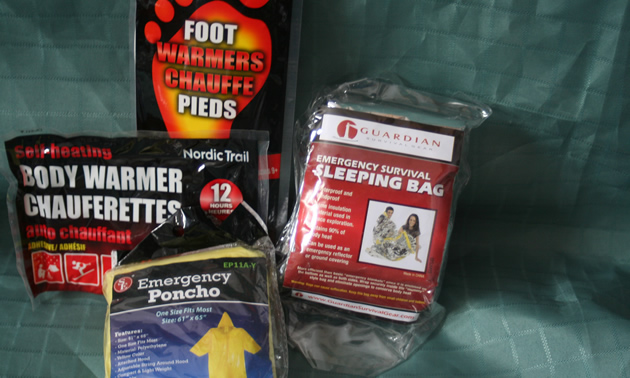
Nasty weather can sneak up on you, so rain gear, mid layers and warming packets can save you from hypothermia should you become stranded. — Trish Drinkle photo
Portable jump box
Portable jump boxes have become a popular must-have accessory for many OHV enthusiasts. They act as a portable charging unit capable of jump-starting many vehicles, including trucks, side-by-sides and ATVs.
Many jump boxes offer the added option of an air compressor, giving you the ability to refill a tire, if needed. Charging accessories for cell phones and other electronics further add to the value of these portable power units.
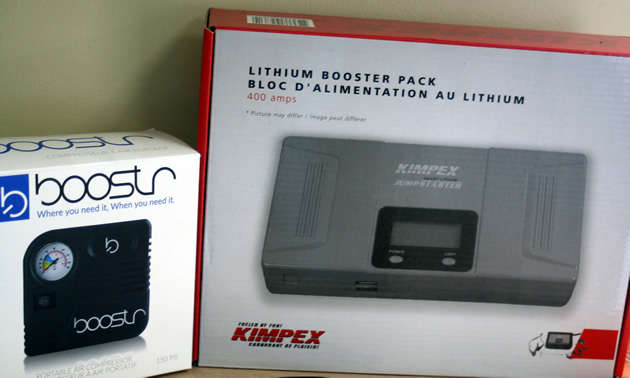
Technological advancements, such as a portable charging jump box and air compressors, are must-haves for your backcountry ORV adventures. — Trish Drinkle photo
Sling and tow rope
A sling is a handy tool to have with you on your side-by-side or ATV, allowing you to quickly attach to logs, stumps or other features that could be blocking your path. Rather than attaching a winch line directly to a tree, which can do damage, a sling will protect the tree and preserve the integrity of your winch line.
A tow rope is also a good idea, giving you a little more length to your winch, while providing a more user-friendly attachment when you’re towing another machine out of a sticky situation.
Saws
A saw—whether it’s a handsaw or a power saw stored in its own quick-attach carrier—is invaluable when exploring the backcountry. Many power saw carriers, available from companies such as Kolpin and Moose Racing, offer compact, user-friendly options.
A hand saw stored in its own protective sheath can also be a life saver, especially if you are stranded and in need of a fire for warmth.
First aid
A basic first-aid kit that includes bandages, tape, wound wash and antiseptic cream or spray is a must.
Antihistamines are another must-pack when out in the wild. Many adventurous explorers have been surprised by a swarm of wasps and other insects that pack a wallop of a sting. If you are on prescription medications that require regular dosage, it is a wise idea to pack extra meds should you have to spend the night in the backcountry unexpectedly.
If any member of your group is allergic to bee or wasp stings, be sure to pack an epinephrine injector and know how to use it.
Survival items
Some basic essentials to your survival kit would include multiple ways to start a fire, fresh drinking water, survival food options, a flashlight, a flare kit, a compass and a GPS device.
Hypothermia is a real concern even in the summer months so hand, foot and body warmers are a handy addition to your survival kit. Survival fire starters on the market today offer dependable flames that are difficult to extinguish.

UCO Stormproof matches are a must-have for any backcountry enthusiast. — Trish Drinkle photo
Your local hunting and outdoors store should carry these fire-starting options that will light a fire, even in the dampest of conditions. Bear spray—worn on your person, not stored on your machine—will give you quick and easy access should you need to use it to fend off charging wildlife.
Outside communication
Always let someone know where you’re headed and when they should expect you back. This type of pre-trip planning can greatly enhance search efforts should you become lost or stranded in the backcountry.
Communication devices, such as a SPOT or InReach, can help you notify search and rescue or loved ones even when cell service is unavailable. Signal flares can be helpful, but caution should always be exercised during hot and/or dry conditions. A mirror and a giant red X made from flagging tape are also effective ways to notify airborne searchers of your location. Two-way radios are helpful for communication within your group and can ensure that your group stays together.
If you are new to the area you are exploring, be sure to make note of any shelters or cabins in the vicinity that could be used in the event of an emergency.
Preparing for the worst can always help you make the best of any situation. Go through the contents of your safety essentials at the beginning of each season. If you need to use any of the consumable items, be sure to replace them before heading out on your next adventure.
Top MacGyver moments
Sometimes, you have to think outside of the box to fix a machine on the fly when you’re deep in the backcountry. While the fixes may not be long lasting or pretty, they can help you get back home without the need for a rescue mission. Click here for a few examples of how thinking outside of the box can save the day.
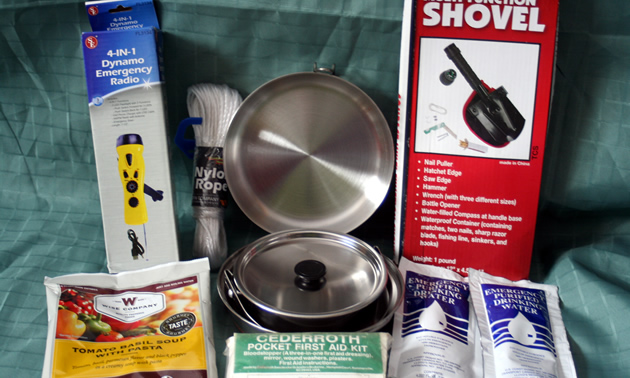



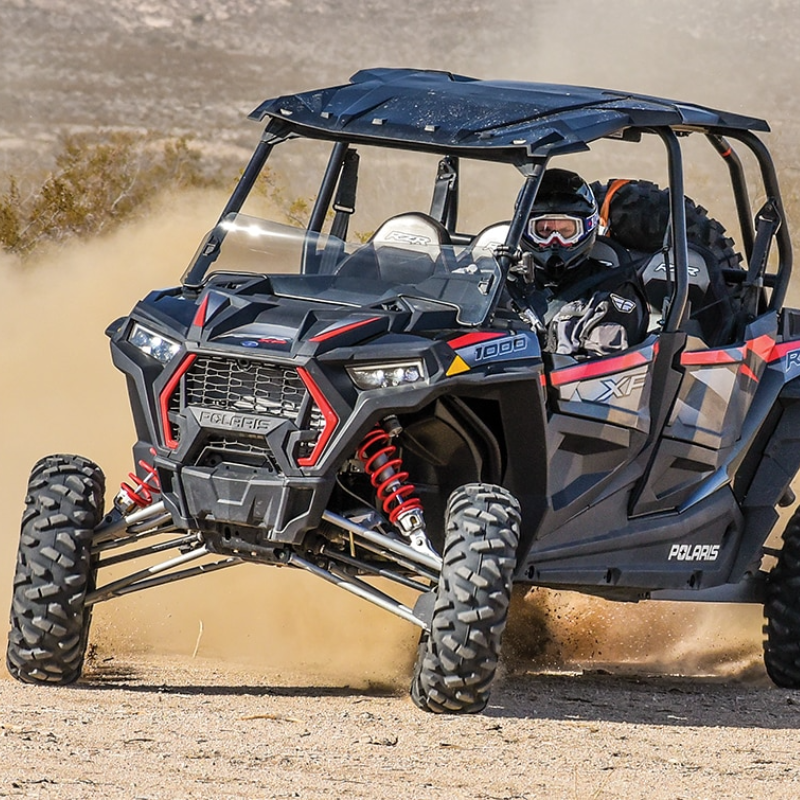



Comments